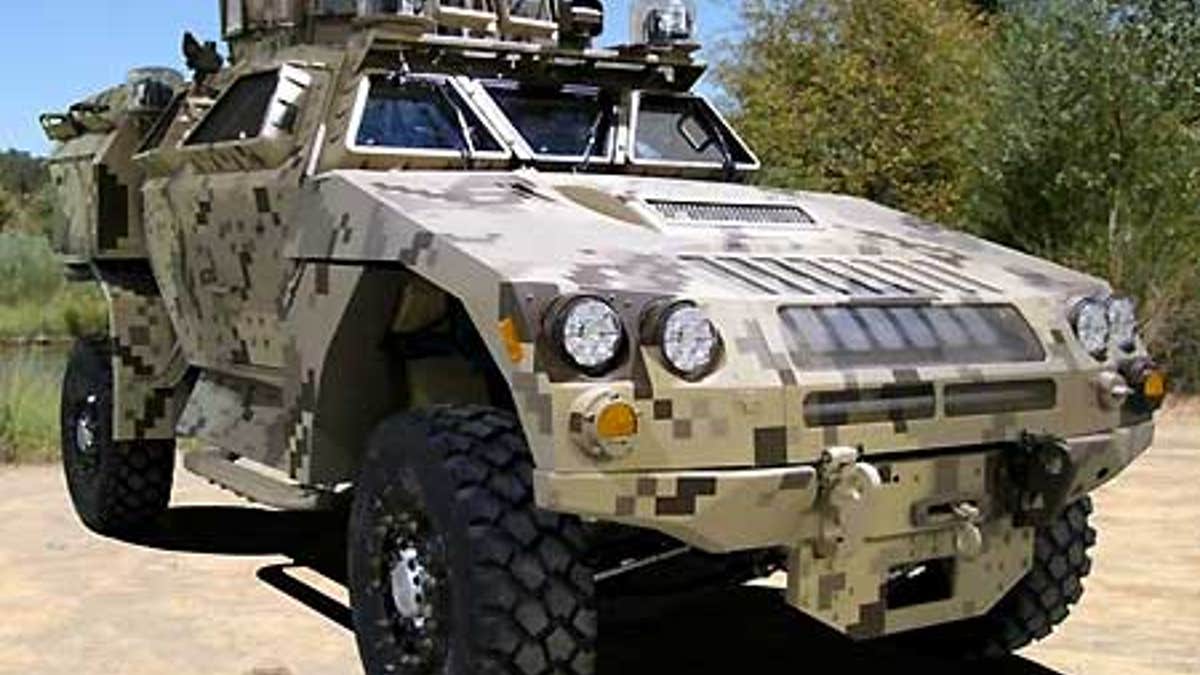
The MRAP All Terrain Vehicle is designed to handle Afghanistan's rough terrain and protect against IED's. (BAE Systems)
Ask any soldier who's been to both countries: Afghanistan is not Iraq. It's a different war against a different enemy in a different country with an entirely different terrain and altitude.
One thing is the same, though. The Improvised Explosive Device — the deadly "IED" roadside bombs that blew up Humvees and the soldiers inside them along the dusty roads of Iraq — is an equally effective weapon in the rocky steeps of Afghanistan.
When the Humvee proved unable to withstand IED attacks in Iraq, the U.S. military built a new vehicle — the Mine Resistant Ambush Protected (MRAP) — to replace it. And like a neglected sibling, the troops in Afghanistan automatically acquired the MRAP as a hand-me-down. It's the wrong vehicle for the new war.
“Best vehicle in Afghanistan? Two legs. And maybe a mule to pack the .50 caliber machine gun,” Arizona National Guardsman Anthony McGee said, only half-jokingly. "Breakdowns were an almost everyday occurrence."
Click here to see video of a an MRAP rolling over in Iraq.
So it's back to the drawing board. Soon there'll be a new king of the road: the MRAP All Terrain Vehicle (M-ATV), nicknamed the "Baby MRAP," which is being "designed for mobility and survivability," says Cheryl Irwin, spokeswoman for the Office of the Secretary of Defense.
As a nation at war for nearly 40 years, the Afghan landscape is peppered with an astounding variety of things that blow up. Along the bare, parched mountains near the border with Pakistan, explosives are more abundant than flowers or trees.
Weight, height, size — all the advantages the MRAP afforded troops in Iraq's urban environments — are all liabilities in a country that barely possesses paved pathways.
Last year, three Green Berets drowned when their MRAP, which is prone to tilting over on uneven terrain, rolled into a canal in southern Afghanistan. The problem was obvious, and the solution is clear: Afghanistan needs a special vehicle for its unique demands.
Enter the M-ATV.
A scaled-down, all-terrain, four-wheel offspring of the larger MRAP, the M-ATV is one of the first tactical vehicles designed specifically with Afghanistan in mind, and the Defense Department has put an urgent priority on getting it into the war zone by the end of this year.
“The M-ATV is designed to have the same level of protection as the previous MRAPs, but with the mobility of a Humvee,” says Steve Field, spokesman for BAE Systems, one of several competing manufacturers designing this vehicle of the future.
Its equipment and capabilities are many:
• IED jammers
• V-shaped blast-dispersing monocoque hull
• Significantly increased power-to-weight ratio
• The ability to ford hard-bottom fresh water to depths of up to 5 feet. (M-ATV is not amphibious)
• Generate 10 kilowatts of vehicle host power and export an additional 20 kilowatts for mission equipment
• Turbo-charged diesel V8 engine
• Shorter wheelbase for improved cross-country mobility
• Lower center of gravity for increased maneuverability and to prevent rollovers
• Ergonomic steering angle to “drive like an SUV”
• “Runflat” tire system allowing the M-ATV to safely cruise at 30 mph on up to two flat tires
To meet future challenges, a new composite “hyperplastic” material capable of absorbing enormous amounts of kinetic energy is the new frontier for armor. This new “composite armor system” has even resisted the deadly energy formed projectile (EFP) class of IED, all while weighing 37 percent less than conventional steel armor.
It's a major victory in the “up armor” race, but in Afghanistan, the IED battle is just beginning.
Hard and rough, the M-ATV is designed with shock absorption in mind. Its independent suspension system is a break from the less flexible standard straight axle systems used in the larger MRAPs.
“This type of train allows each wheel a bit more mobility,” said suspension systems guru Scott Arentz of Extremegearoffroad.com. “The independent drivetrain requires a few more parts and is more 'delicate,' but it usually gives a smoother ride.”
An added bonus of the M-ATV is that it will be a money-saver. A barebones unit will cost roughly $500,000, compared to $1 million for an MRAP.
The far lighter M-ATV will also cost much less to deliver to landlocked Afghanistan. The military estimates that airlifting each MRAP into Afghanistan costs $135,000 — and there currently are 1,800 MRAPs in the country.
“The key here is survivability," Irwin said. "We want to protect our people and give them what they need to succeed in their mission....
"I hate the term 'baby' MRAP," she said, referring to the nickname the nimble 4x4 has acquired.
And well she might. The M-ATV must hit the ground running, which is precisely what the military expects it to do. In Afghanistan, there will be no time to crawl.
